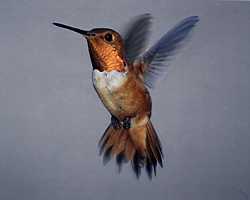Rufous Hummingbird
(Selasphorus Rufus)

Description
The Rufous Hummingbird is the second most common species observed in Ontario. At 9-10 cm (3.5-4 in) in length, it is slightly larger than the Ruby-throated and has a somewhat rounder appearance. Adult males can only be confused with the Allen's Hummingbird which is very similar in appearance. The adult male Rufous generally has a back that is entirely rufous in colour or has a small amount of green. Occasionally, the Rufous male will have a large amount of green on the back making it almost impossible to separate from Allen's without taking measurements and carefully examining specific feathers. Both Allen's and Rufous females and young can be difficult to separate from many other hummingbird species without examining them in hand during banding.
"Hannah" is the most well-known Rufous hummingbird to visit Ontario thanks to the generosity of her hosts in Niagara Falls, Art and Janice Haines. Several hundred birders had an opportunity to see this female rufous coming to their feeder in late 2004. Feeders were brought in at night and one was prevented from freezing with the use of a heat lamp. "Callie" treated visitors at the London home of Dale and Alice Kenzie in November and early December 2005. The homeowner kept the feeders scrupulously clean and changed them every 30-60 minutes during the coldest weather in December to prevent freezing. Cindy Cartwright was able to obtain a breast feather, which had frozen to the feeder while Callie was feeding, during a visit on December 9, 2005. The feather was delivered to the University of Guelph for DNA bar coding through the Bar Code of Life Project Callie was the first Rufous Hummingbird in Ontario to be identified by DNA testing from a single breast feather. The Hummingbirds Canada will continue to provide feathers to the Bar Code of Life Project.
The Rufous Hummingbird is a very hardy bird which breeds in British Columbia, western Alberta and the southern part of the Yukon Territory. It has been documented arriving on the most northern breeding grounds by the first of May each year but may arrive earlier. The Rufous Hummingbird also breeds along the southern coast of Alaska, Washington (state), and Oregon.
It is not unusual for temperatures to drop near or below zero at night in the northern-most areas during the nesting season. There have been anecdotal reports of Rufous females sitting on nests, dusted with snow in the far northern portions of their breeding range. The ability to tolerate much colder temperatures means that Rufous Hummingbirds visiting Ontario can stay later in the fall after the Ruby-throats have left for warmer areas. This is the time when they are most likely to be reported. One theory is that these birds move further south in timing with the winter solstice (Allen Chartier, pers. com).
These birds are not lost or doomed to die. Research in the United States has shown that many Rufous Hummingbirds migrate on a northwest to southeast pathway. Several have been recaptured further south, later in the wintering season. One Rufous Hummingbird, originally banded by Susan Campbell in North Carolina, was recaptured in Michigan the following fall, proving that these birds do survive.
It is believed that more Rufous Hummingbirds visit Ontario than are documented. Most are missed because hummingbirds move so quickly that it is difficult for most people to get a good look at key identification features. Many people don't look at hummingbirds very carefully because it is commonly believed that the Ruby-throated Hummingbird is the only species found east of the Mississippi River. One of the goals of the Hummingbirds Canada is to identify how many Rufous Hummingbirds visit Ontario each year. Another goal is to document all species of hummingbirds visiting Ontario.
Hummingbirds Canada should be notified at hummingbirds@bmts.com or 519-797-1313 as soon as possible if a Rufous or other unusual hummingbird is observed.